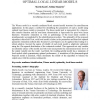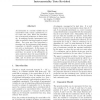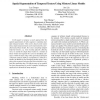EMNLP
2011
13 years 6 months ago
2011
Linear models have enjoyed great success in structured prediction in NLP. While a lot of progress has been made on efficient training with several loss functions, the problem of ...
CORR
2010
Springer
14 years 4 months ago
2010
Springer
We consider linear models for stochastic dynamics. To any such model can be associated a network (namely a directed graph) describing which degrees of freedom interact under the d...
NECO
1998
14 years 6 months ago
1998
We introduce a constructive, incremental learning system for regression problems that models data by means of spatially localized linear models. In contrast to other approaches, t...
SIMPRA
2008
14 years 6 months ago
2008
The Wiener model is a versatile nonlinear block oriented model structure for miscellaneous applications. In this paper a method for identifying the parameters of such a model usin...
IJCAI
1989
14 years 7 months ago
1989
Perturbation analysis deals with the relation ships between small changes in a system's inputs or model and changes in its outputs. Reverse simulation is of particular inte...
UAI
2001
14 years 7 months ago
2001
An instrument is a random variable that is uncorrelated with certain (unobserved) error terms and, thus, allows the identification of structural parameters in linear models. In no...
AVI
2004
14 years 7 months ago
2004
In this paper we propose ValueCharts, a set of visualizations and interactive techniques intended to support decision-makers in inspecting linear models of preferences and evaluat...
ECCV
2006
Springer
14 years 10 months ago
2006
Springer
In this paper we propose a novel approach for the spatial segmentation of video sequences containing multiple temporal textures. This work is based on the notion that a single tem...
DAGM
2006
Springer
14 years 10 months ago
2006
Springer
In this paper we extend anisotropic diffusion with a diffusion tensor to be applicable to data that is well modeled by linear models. We focus on its variational theory, and invest...
HICSS
2003
IEEE
14 years 11 months ago
2003
IEEE
1 In the complexity and simulation communities there is growing support for the use of bottom-up computer-based simulation in the analysis of complex systems. The presumption is th...



